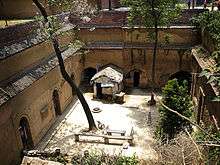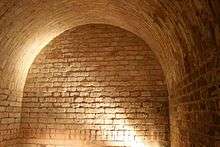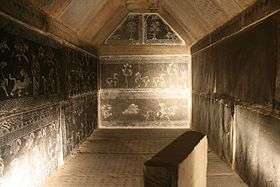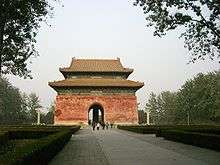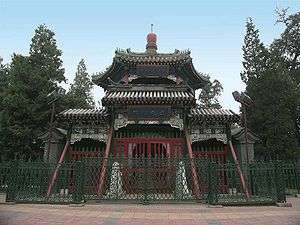Chinese architecture
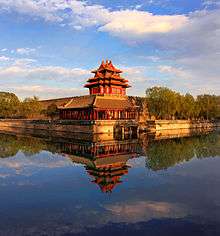
Chinese architecture is a style of architecture that has taken shape in East Asia over many centuries. The structural principles of Chinese architecture have remained largely unchanged, the main changes being only the decorative details. Since the Tang Dynasty, Chinese architecture has had a major influence on the architectural styles of Korea, Vietnam, and Japan.
The architecture of China is as old as Chinese civilization. From every source of information—literary, graphic, exemplary—there is strong evidence testifying to the fact that the Chinese have always enjoyed an indigenous system of construction that has retained its principal characteristics from prehistoric times to the present day. Over the vast area from Chinese Turkistan to Japan, from Manchuria to the northern half of French Indochina, the same system of construction is prevalent; and this was the area of Chinese cultural influence. That this system of construction could perpetuate itself for more than four thousand years over such a vast territory and still remain a living architecture, retaining its principal characteristics in spite of repeated foreign invasions—military, intellectual, and spiritual—is a phenomenon comparable only to the continuity of the civilization of which it is an integral part.— Liang, Ssu-ch'eng, 1984[1]
Throughout the 20th Century, Western-trained Chinese architects have attempted to combine traditional Chinese designs into modern architecture (usually government), with only limited success. Moreover, the pressure for urban development throughout contemporary China required higher speed of construction and higher floor area ratio, which means that in the great cities the demand for traditional Chinese buildings, which are normally less than 3 levels, has declined in favor of modern architecture. However, the traditional skills of Chinese architecture, including major and minor carpentry, masonry, and stonemasonry, are still applied to the construction of vernacular architecture in the vast rural area in China.
Features

The rectangular compound shown above has two sections of courtyards. The buildings on the axle line include central entrance, four-pointed pavilion, mountain-shaped front hall, artificial mountain and ponds, eight-pointed pavilion and mountain-shaped retiring quarters. The two sides of the central axle are arranged with corridor rooms symmetrically.
Architectural bilateral symmetry
A very important feature in Chinese architecture is its emphasis on articulation and bilateral symmetry, which signifies balance. Bilateral symmetry and the articulation of buildings are found everywhere in Chinese architecture, from palace complexes to humble farmhouses. When possible, plans for renovation and extension of a house will often try to maintain this symmetry provided that there is enough capital to do so.[2] Secondary elements are positioned either side of main structures as two wings to maintain overall bilateral symmetry. The buildings are typically planned to contain an even number of columns in a structure to produce an odd number of bays (間). With the inclusion of a main door to a building in the center bay, symmetry is maintained.
In contrast to the buildings, Chinese gardens are a notable exception which tend to be asymmetrical. The principle underlying the garden's composition is to create enduring flow.[3]
Enclosure
In much of traditional Chinese architecture, buildings or building complexes take up an entire property but enclose open spaces within themselves. These enclosed spaces come in two forms, the:[2]
- Courtyard (院): The use of open courtyards is a common feature in many types of Chinese architectures. This is best exemplified in the Siheyuan, which has consisted of an empty space surrounded by buildings connected with one another either directly or through verandas.
- "Sky well" (天井): Although large open courtyards are less commonly found in southern Chinese architecture, the concept of an "open space" surrounded by buildings, which is seen in northern courtyard complexes, can be seen in the southern building structure known as the "sky well". This structure is essentially a relatively enclosed courtyard formed from the intersections of closely spaced buildings and offer small opening to the sky through the roof space from the floor up.
These enclosures serve in temperature regulation and in venting the building complexes. Northern courtyards are typically open and facing the south to allow the maximum exposure of the building windows and walls to the sun while keeping the cold northern winds out. Southern sky wells are relatively small and serves to collect rain water from the roof tops. They perform the same duties as the Roman impluvium while restricting the amount of sunlight that enters the building. Sky wells also serve as vents for rising hot air, which draws cool air from the lower stories of the house and allows for exchange of cool air with the outside.
|
Hierarchy
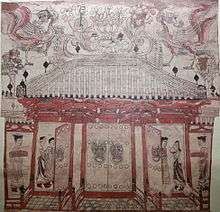
The projected hierarchy and importance and uses of buildings in traditional Chinese architecture are based on the strict placement of buildings in a property/complex. Buildings with doors facing the front of the property are considered more important than those facing the sides. Buildings facing away from the front of the property are the least important.
South-facing buildings in the rear and more private location of the property with higher exposure to sunlight are held in higher esteem and reserved for elder members of the family or ancestral plaques. Buildings facing east and west are generally for junior members of the family, while buildings near the front are typically for servants and hired help.[4]
Front-facing buildings in the back of properties are used particularly for rooms of celebratory rites and for the placement of ancestral halls and plaques. In multiple courtyard complexes, central courtyards and their buildings are considered more important than peripheral ones, the latter typically being used as storage or servants’ rooms or kitchens.[2]
Horizontal emphasis
Classical Chinese buildings, especially those of the wealthy, are built with an emphasis on breadth and less on height, featuring an enclosed heavy platform and a large roof that floats over this base, with the vertical walls not well emphasized. This contrasts Western architecture, which tends to grow in height and depth. Chinese architecture stresses the visual impact of the width of the buildings.
The halls and palaces in the Forbidden City, for example, have rather low ceilings when compared to equivalent stately buildings in the West, but their external appearances suggest the all-embracing nature of imperial China. These ideas have found their way into modern Western architecture, for example through the work of Jørn Utzon.[5] This of course does not apply to pagodas, which are limited to religious building complexes.

Cosmological concepts

Chinese architecture from early times used concepts from Chinese cosmology such as feng shui (geomancy) and Taoism to organize construction and layout from common residences to imperial and religious structures.[2] This includes the use of:
- Screen walls to face the main entrance of the house, which stems from the belief that evil things travel in straight lines.
- Talismans and imagery of good fortune:
- Door gods displayed on doorways to ward off evil and encourage the flow of good fortune
- Three anthropomorphic figures representing Fu Lu Shou (福祿壽 fú-lù-shòu) stars are prominently displayed, sometimes with the proclamation "the three stars are present" (三星在 sān-xīng-zài)
- Animals and fruits that symbolize good fortune and prosperity, such as bats and pomegranates, respectively. The association is often done through rebuses.
- Orienting the structure with its back to elevated landscape and ensuring that there is water in the front. Considerations are also made such that the generally windowless back of the structure faces the north, where the wind is coldest in the winter.
- Ponds, pools, wells, and other water sources are usually built into the structure.
The use of certain colors, numbers and the cardinal directions in traditional Chinese architecture reflected the belief in a type of immanence, where the nature of a thing could be wholly contained in its own form. Although the Western tradition gradually developed a body of architectural literature, little was written on the subject in China, and the earliest text, the Kaogongji, was never disputed. However, ideas about cosmic harmony and the order of the city were usually interpreted at their most basic level, so a reproduction of the "ideal" city never existed. Beijing as reconstructed throughout the 15th and 16th century remains one of the best examples of traditional Chinese town planning.
Construction
Materials and history
Unlike other building construction materials, old wooden structures often do not survive because they are more vulnerable to weathering and fires and are naturally subjected to rotting over time. Although now-nonexistent wooden residential towers, watchtowers, and pagodas predated it by centuries, the Songyue Pagoda built in 523 is the oldest extant pagoda in China; its use of brick instead of wood had much to do with its endurance throughout the centuries. From the Tang Dynasty (618–907) onwards, brick and stone architecture gradually became more common and replaced wooden edifices. The earliest examples of this transition can be seen in building projects such as the Zhaozhou Bridge completed in 605 or the Xumi Pagoda built in 636, yet stone and brick architecture is known to have been used in subterranean tomb architecture of earlier dynasties.
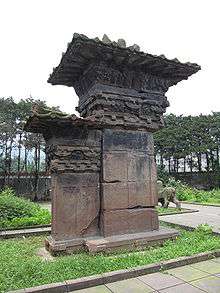
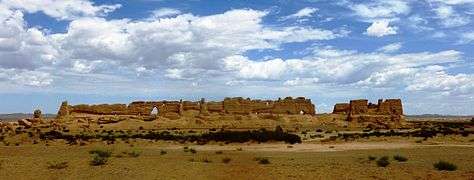
In the early 20th century there were no known fully wood-constructed Tang Dynasty buildings that still existed; the oldest so far discovered was the 1931 find of Guanyin Pavilion at Dule Monastery, dated 984 during the Song.[9] This was until the architectural historians Liang Sicheng (1901–1972), Lin Huiyin (1904–1955), Mo Zongjiang (1916–1999), and (1902–c. 1960s) discovered that the Great East Hall of Foguang Temple on Mount Wutai in Shanxi was reliably dated to the year 857 in June 1937.[9] The groundfloor dimensions for this monastic hall measures 34 by 17.66 m (111.5 by 57.9 ft).[10] A year after the discovery at Foguang, the main hall of nearby Nanchan Temple on Mount Wutai was reliably dated to the year 782,[11] while a total of six Tang era wooden buildings have been found by the 21st century.[12] The oldest existent fully wooden pagoda that has survived intact is the Pagoda of Fogong Temple of the Liao Dynasty, located in Ying County of Shanxi. While the East Hall of Foguang Temple features only seven types of bracket arms in its construction, the 11th century Pagoda of Fogong Temple features a total of fifty-four.[13]
The earliest walls and platforms in China were of rammed earth construction, and over time brick and stone became more frequently used. This can be seen in ancient sections of the Great Wall of China, while the brick and stone Great Wall seen today is a renovation of the Ming Dynasty (1368–1644).
Structure
- Foundations: Most buildings are typically erected on raised platforms (臺基) as their foundations. Vertical structural beams may rest on raised stone pedestals (柱础) which occasionally rest on piles. In lower class construction, the platforms are constructed of rammed earth platforms that are unpaved or paved with brick or ceramics. In the simplest cases vertical structural beams are driven into the ground directly. Upper class constructions typically have high raised stone paved rammed earth or stone foundations with ornately carved heavy stone pedestals for supporting large vertical structural beams.[4] The vertical beams rest and remain on their pedestals solely by friction and the pressure exerted by the building structure.[14]
- Structural beams: Use of large structural timbers for primary support of the roof of a building. Wooden timber, usually large trimmed logs, are used as load-bearing columns and lateral beams for framing buildings and supporting the roofs. These beams are connected to each other directly or, in larger and higher class structures, tied indirectly together through the use of brackets. These structural timbers are prominently displayed in finished structures. It is not definitively known how the ancient builders raised the huge wooden load bearing columns into position.
- Structural connections: Timber frames are typically constructed with joinery and doweling alone, seldom with the use of glue or nails. These types of semi-rigid structural joints allow the timber structure to resist bending and torsion while under high compression.[4] Structural stability is further ensured through the use of heavy beams and roofs, which weighs the structure down.[14] The lack of glue or nails in joinery, the use of non-rigid support such as dougong, and the used of wood as structural members allow the buildings to slide, flex, and hinge while absorbing shock, vibration, and groundshift from earthquakes without significant damage to its structure.[4]
- Walls: The common use of curtain walls or door panels to delineate rooms or enclose a building, with the general de-emphasis of load-bearing walls in most higher class construction. However, with the reduction in availability of trees in the later dynasties for building structures, the use of load-bearing walls in non-governmental or religious construction increased, with brick and stone being commonly used.
- Roofs: Flat roofs are uncommon while gabled roofs are almost omnipresent in traditional Chinese architecture. Roofs are either built on roof cross-beams or rest directly on vertical structural beams. In higher class construction, roof supporting beams are supported through complex dougong bracketing systems that indirectly connect them to the primary structural beams.[4] Three main types of roofs are found:
- Straight inclined: Roofs with a single incline. These are the most economical type of roofing and are most prevalent in commoner architectures.
- Multi-inclined: Roofs with 2 or more sections of incline. These roofs are used in higher class constructions, from the dwellings of wealthy commoners to palaces.
- Sweeping: Roofs with a sweeping curvature that rises at the corners of the roof. This type of roof construction is usually reserved for temples and palaces although it may also be found in the homes of the wealthy. In the former cases, the ridges of the roof are usually highly decorated with ceramic figurines.
- Roof apex: The roof apex of a large hall is usually topped with a ridge of tiles and statues for both decorative purposes as well as to weigh down the layers of roofing tiles for stability. These ridges are often well decorated, especially for religious or palatial structures. In some regions of China, the ridges are sometimes extended or incorporated into the walls of the building to form matouqiang (horse-head walls), which serve as a fire deterrent from drifting embers.
- Roof top decorations: Symbolism can be found from colors of the eaves, roofing materials and roof top decorations. Gold/yellow is an auspicious (good) color, imperial roofs are gold or yellow. They are usually used by the emperor. Green roofs symbolize bamboo shafts, which, in turn, represent youth and longevity.[15]
Classification by structure

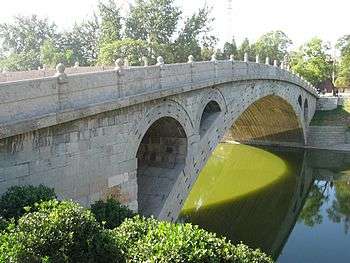
Chinese classifications for architecture include:
- 亭 (Chinese: 亭; pinyin: Tíng) ting (Chinese pavilions)
- 臺 (simplified Chinese: 台; traditional Chinese: 臺; pinyin: Taí) tai (terraces)
- 樓 (simplified Chinese: 楼; traditional Chinese: 樓; pinyin: Lóu) lou (Multistory buildings)
- 閣 (simplified Chinese: 阁; traditional Chinese: 閣; pinyin: Gé) ge (Two-story pavilions)
- 軒 (轩) xuan (Verandas with windows)
- 塔 ta (Chinese pagodas)
- 榭 xie (Pavilions or houses on terraces)
- 屋 wu (Rooms along roofed corridors)
- 斗拱(Chinese: 斗拱; pinyin: Dǒugǒng) dougong interlocking wooden brackets, often used in clusters to support roofs and add ornamentation.
- 藻井 Caisson domed or coffered ceiling
Architectural types
Commoner
The houses of commoners, be they bureaucrats, merchants or farmers, tended to follow a set pattern: the center of the building would be a shrine for the deities and the ancestors, which would also be used during festivities. On its two sides were bedrooms for the elders; the two wings of the building (known as "guardian dragons" by the Chinese) were for the junior members of the family, as well as the living room, the dining room, and the kitchen, although sometimes the living room could be very close to the center.
Sometimes the extended families became so large that one or even two extra pairs of "wings" had to be built. This resulted in a U-shaped building, with a courtyard suitable for farm work. Merchants and bureaucrats, however, preferred to close off the front with an imposing front gate. All buildings were legally regulated, and the law held that the number of stories, the length of the building and the colours used depended on the owner's class. Some commoners living in areas plagued by bandits built communal fortresses called Tulou for protection.
Imperial
There were certain architectural features that were reserved solely for buildings built for the Emperor of China. One example is the use of yellow roof tiles, yellow having been the Imperial color; yellow roof tiles still adorn most of the buildings within the Forbidden City. The Temple of Heaven, however, uses blue roof tiles to symbolize the sky. The roofs are almost invariably supported by brackets ("dougong"), a feature shared only with the largest of religious buildings. The wooden columns of the buildings, as well as the surfaces of the walls, tend to be red in color. Black is also a famous color often used in pagodas. It was believed that the gods are inspired by the black color to descend to the earth.
The Chinese 5-clawed dragon, adopted by the first Ming emperor for his personal use, was used as decoration on the beams, pillars, and on the doors on Imperial architecture. Curiously, the dragon was never used on roofs of imperial buildings.
Only the buildings used by the imperial family were allowed to have nine jian (間, space between two columns); only the gates used by the Emperor could have five arches, with the centre one, of course, being reserved for the Emperor himself. The ancient Chinese favored the color red. The buildings faced south because the north had a cold wind.
|
Beijing became the capital of China after the Mongol invasion of the 13th century, completing the easterly migration of the Chinese capital begun since the Jin dynasty. The Ming uprising in 1368 reasserted Chinese authority and fixed Beijing as the seat of imperial power for the next five centuries. The Emperor and the Empress lived in palaces on the central axis of the Forbidden City, the Crown Prince at the eastern side, and the concubines at the back (therefore the numerous imperial concubines were often referred to as "The Back Palace Three Thousand"). However, during the mid-Qing Dynasty, the Emperor's residence was moved to the western side of the complex. It is misleading to speak of an axis in the Western sense of a visual perspective ordering facades, rather the Chinese axis is a line of privilege, usually built upon, regulating access—there are no vistas, but a series of gates and pavilions.
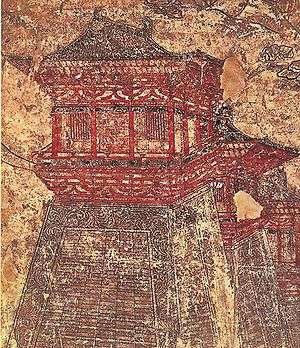
Numerology heavily influenced Imperial Architecture, hence the use of nine in much of construction (nine being the greatest single digit number) and the reason why the Forbidden City in Beijing is said to have 9,999.9 rooms—just short of the mythical 10,000 rooms in heaven. The importance of the East (the direction of the rising sun) in orienting and siting Imperial buildings is a form of solar worship found in many ancient cultures, where there is the notion of Ruler being affiliated with the Sun.
The tombs and mausoleums of imperial family members, such as the 8th century Tang Dynasty tombs at the Qianling Mausoleum, can also be counted as part of the imperial tradition in architecture. These above-ground earthen mounds and pyramids had subterranean shaft-and-vault structures that were lined with brick walls since at least the Warring States (481–221 BC).[16]
Religious
Generally speaking, Buddhist architecture follows the imperial style. A large Buddhist monastery normally has a front hall, housing the statue of a Bodhisattva, followed by a great hall, housing the statues of the Buddhas. Accommodations for the monks and the nuns are located at the two sides. Some of the greatest examples of this come from the 18th century Puning Temple and Putuo Zongcheng Temple. Buddhist monasteries sometimes also have pagodas, which may house the relics of the Gautama Buddha; older pagodas tend to be four-sided, while later pagodas usually have eight sides.
Daoist architecture, on the other hand, usually follows the commoners' style. The main entrance is, however, usually at the side, out of superstition about demons which might try to enter the premise (see feng shui.) In contrast to the Buddhists, in a Daoist temple the main deity is located in the main hall at the front, the lesser deities in the back hall and at the sides.
-

A group of temples at the top of Mount Taishan, where structures have been built at the site since the 3rd century BC during the Han Dynasty
-
The Songyue Pagoda, built in 523 AD during the Northern and Southern dynasties
-

The Giant Wild Goose Pagoda in Xi'an, built in 652 during the Tang Dynasty
-

The Nine Pinnacle Pagoda, built in the 8th century during the Tang Dynasty
-
A timber hall built in 857 during the Tang Dynasty,[1] located at the Buddhist Foguang Temple in Mount Wutai, Shanxi
-

The Three Pagodas of Chong Sheng Temple, Dali City, Yunnan, built in the 9th and 10th century
-
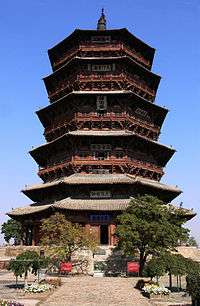
The Fogong Temple Pagoda, located in Ying county, Shanxi province, built in 1056 during the Liao Dynasty, is the oldest existent fully wooden pagoda in China
-
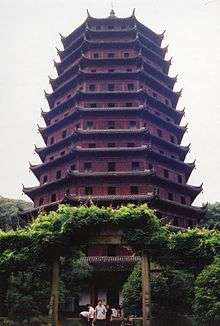
The Liuhe Pagoda of Hangzhou, China, built in 1165 AD during the Song Dynasty
-

The Temple of Heaven in Beijing, built in the 15th century during the Ming Dynasty
-
The Putuo Zongcheng Temple, built from 1767 to 1771 during the reign of Qianlong, represents a fusion of Chinese and Tibetan architectural style
-
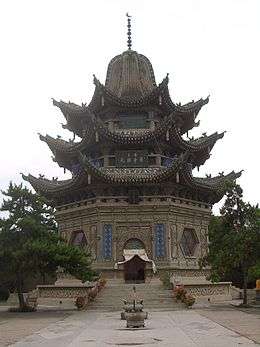
Hua Si Gongbei (the mausoleum of Ma Laichi) in Linxia City, Gansu
-

A Chinese pavilion instead of a minaret at the Great Mosque of Xi'an.
-

Island Pagoda, about 1871, from the album, Foochow and the River Min
- ^ Steinhardt (2004), 228–229.
The tallest pre-modern building in China was built for both religious and martial purposes. The Liaodi Pagoda of 1055 AD stands at a height of 84 m (276 ft), and although it served as the crowning pagoda of the Kaiyuan monastery in old Dingzhou, Hebei, it was also used as a military watchtower for Song Dynasty soldiers to observe potential Liao Dynasty enemy movements.
The architecture of the mosques and gongbei tomb shrines of China's Muslims often combines traditional Chinese styles with Middle Eastern influences.
Urban planning
Chinese urban planning is based on fengshui geomancy and the well-field system of land division, both used since the Neolithic age. The basic well-field diagram is overlaid with the luoshu, a magic square divided into 9 sub-squares, and linked with Chinese numerology.[17]
Miniature models
Although mostly only ruins of brick and rammed earth walls and towers from ancient China (i.e. before the 6th century AD) have survived, information on ancient Chinese architecture (especially wooden architecture) can be discerned from more or less realistic clay models of buildings created by the ancient Chinese as funerary items. This is similar to the paper joss houses burned in some modern Chinese funerals. The following models were made during the Han Dynasty (202 BC – AD 220):
During the Jin Dynasty (265–420) and the Six Dynasties, miniature models of buildings or entire architectural ensembles were often made to decorate the tops of the so-called "soul vases" (hunping), found in many tombs of that period.[18]
See also
|
References
Citations
- ↑ Liang, Ssu-ch'eng, year 12, A pictorial history of Chinese architecture : a study of the development of its structural system and the evolution of its types, ed. by Wilma Fairbank, Cambridge (Mass.): MIT Press.
- 1 2 3 4 Knapp, Ronald G. (2006), Chinese Houses: The Architectural Heritage of a Nation, Tuttle Publishing, ISBN 978-0-8048-3537-4
- ↑ Handler, Sarah (January 19, 2005), Ming Furniture in the Light of Chinese Architecture, Ten Speed Press
- 1 2 3 4 5 浙江长城纪实文化传播公司 (2004), 中国古建筑, 齊魯音像出版社出版发行, ISBN 978-7-88408-237-7
- ↑ Weston, Richard (2002), Utzon, Edition Blondal, p. 221, ISBN 978-87-88978-98-8
- ↑ Liu, Xujie (2002). "The Qin and Han Dynasties" in Chinese Architecture, 33–60. Edited by Nancy S. Steinhardt. New Haven: Yale University Press. ISBN 0-300-09559-7. Page 55.
- ↑ Steinhardt, Nancy N. (2005). "Pleasure tower model," in Recarving China's Past: Art, Archaeology, and Architecture of the 'Wu Family Shrines', 275–281. Edited by Naomi Noble Richard. New Haven and London: Yale University Press and Princeton University Art Museum. ISBN 0-300-10797-8. Pages 279–280.
- ↑ Wang Xudang, Li Zuixiong, and Zhang Lu (2010). "Condition, Conservation, and Reinforcement of the Yumen Pass and Hecang Earthen Ruins Near Dunhuang", in Neville Agnew (ed), Conservation of Ancient Sites on the Silk Road: Proceedings of the Second International Conference on the Conservation of Grotto Sites, Mogao Grottoes, Dunhuang, People's Republic of China, June 28 - July 3, 2004, 351-357. Los Angeles: The Getty Conservation Institute, J. Paul Getty Trust. ISBN 978-1-60606-013-1, pp 351-352.
- 1 2 Steinhardt, Nancy Shatzman. "The Tang Architectural Icon and the Politics of Chinese Architectural History," The Art Bulletin (Volume 86, Number 2, 2004): 228–254. Page 228.
- ↑ Steinhardt, Nancy Shatzman. "The Tang Architectural Icon and the Politics of Chinese Architectural History," The Art Bulletin (Volume 86, Number 2, 2004): 228–254. Page 233.
- ↑ Steinhardt, Nancy Shatzman. "The Tang Architectural Icon and the politics of Chinese Architectural History," The Art Bulletin (Volume 86, Number 2, 2004): 228–254. Page 228–229.
- ↑ Steinhardt, Nancy Shatzman. "The Tang Architectural Icon and the Politics of Chinese Architectural History," The Art Bulletin (Volume 86, Number 2, 2004): 228–254. Page 238.
- ↑ Steinhardt, Nancy Shatzman. "Liao: An Architectural Tradition in the Making," Artibus Asiae (Volume 54, Number 1/2, 1994): 5–39. Page 13.
- 1 2 YU, Maohong; ODA, Yoshiya; FANG, Dongping; ZHAO, Junhai (2008), "Advances in structural mechanics of Chinese ancient architectures", Front. Archit. Civ. Eng. China, 2 (1): 1–25, doi:10.1007/s11709-008-0002-1
- ↑ http://www1.chinaculture.org/gb/en_chinaway/2004-03/10/content_46273.htm
- ↑ Guo, Qinghua. "Tomb Architecture of Dynastic China: Old and New Questions," Architectural History (Volume 47, 2004): 1–24. Page 12.
- ↑ Schinz, 1996
- ↑ Dien, Albert E. (2007), Six dynasties civilization, Early Chinese civilization series, Yale University Press, pp. 214–215, ISBN 0-300-07404-2
Sources
- Liang, Ssu-ch'eng 1984, A pictorial history of Chinese architecture: a study of the development of its structural system and the evolution of its types, ed. by Wilma Fairbanks, Cambridge (Mass.): MIT Press
- Schinz, Alfred (1996), The magic square: cities in ancient China, Edition Axel Menges, p. 428, ISBN 3-930698-02-1
- Steinhardt, Nancy Shatzman. "Liao: An Architectural Tradition in the Making," Artibus Asiae (Volume 54, Number 1/2, 1994): 5–39.
- Steinhardt, Nancy Shatzman. "The Tang Architectural Icon and the Politics of Chinese Architectural History," The Art Bulletin (Volume 86, Number 2, 2004): 228–254.
- Weston, Richard. 2002. Utzon : inspiration, vision, architecture. Hellerup: Blondal.
Further reading
- Fletcher, Banister; Cruickshank, Dan, Sir Banister Fletcher's a History of Architecture, Architectural Press, 20th edition, 1996 (first published 1896). ISBN 0-7506-2267-9. Cf. Part Four, Chapter 24.
- Sickman L and Soper A. The Art and Architecture of China (Penguin Books, 1956).
- KNAPP, RONALD G. (2000). CHINA'S OLD DWELLINGS. University of Hawai'i Press. ISBN 0-8248-2075-4. Archived from the original on 10 September 2016. Retrieved 10 September 2016.
External links
| Wikimedia Commons has media related to Architecture of China. |
- Yin Yu Tang: A Chinese Home To explore an in depth look into the ancient architecture of the Huang family’s domestic life in China, the Yin Yu Tang house offers an interactive view of the typical domestic architecture of the Qing dynasty.
- Herbert Offen Research Collection An excellent bibliography of publicly accessible books and manuscripts on Chinese architecture.
- Islamic Architecture in China Introduction to the Chinese Mosques in South, West, and North respectively
- Chinese Vernacular Architecture & General Chinese Architecture--Web Links Chinese Vernacular Architecture & General Chinese Architecture—Web Links
- Chinese Residential Houses Ten types of Chinese residential houses
- Asian Historical Architecture
- Web Resources of Chinese Architecture History


